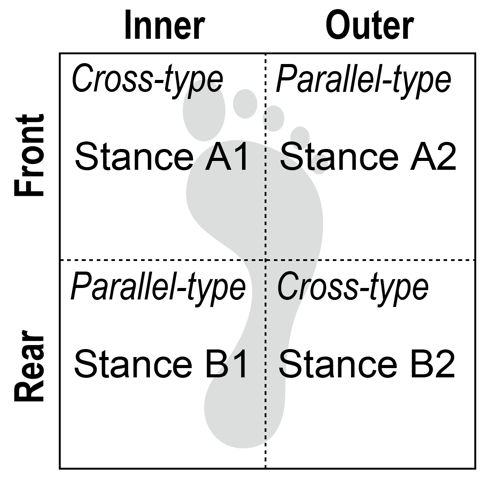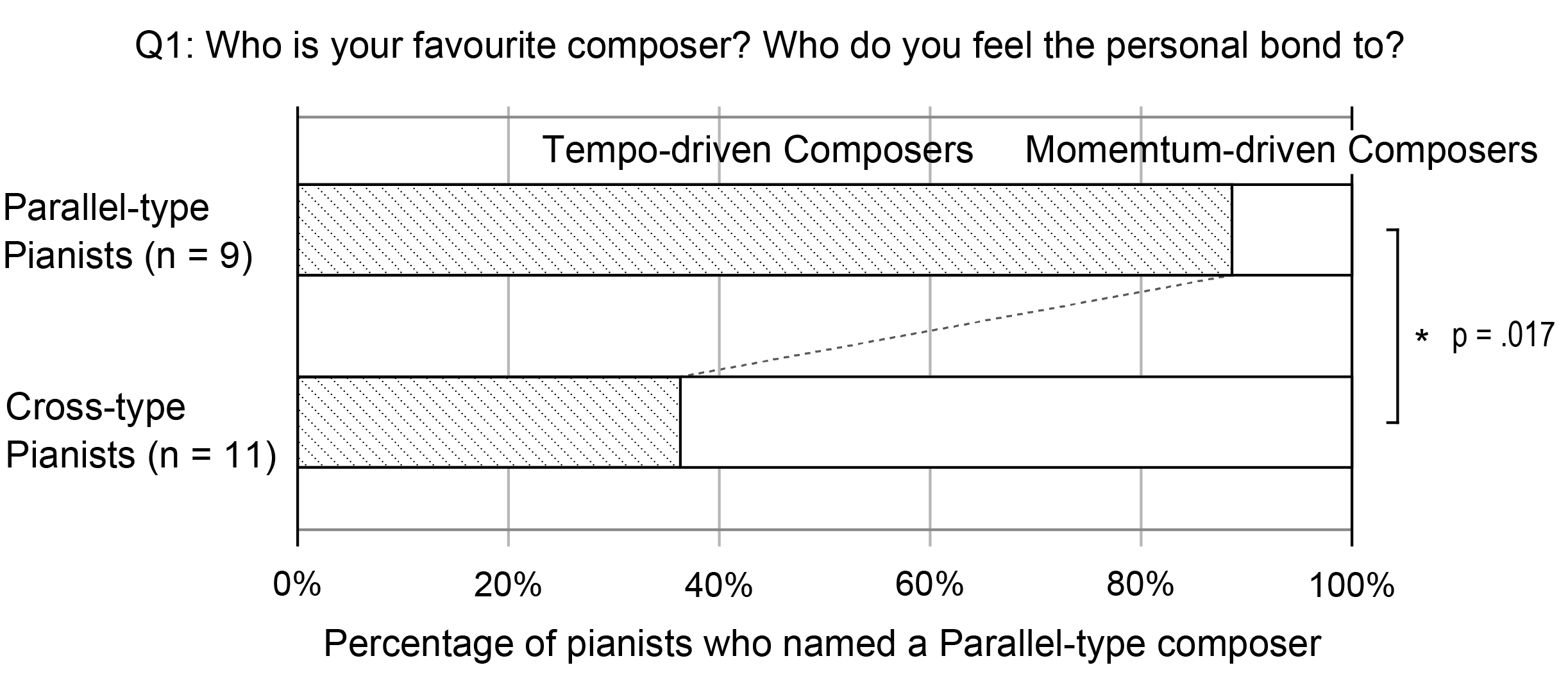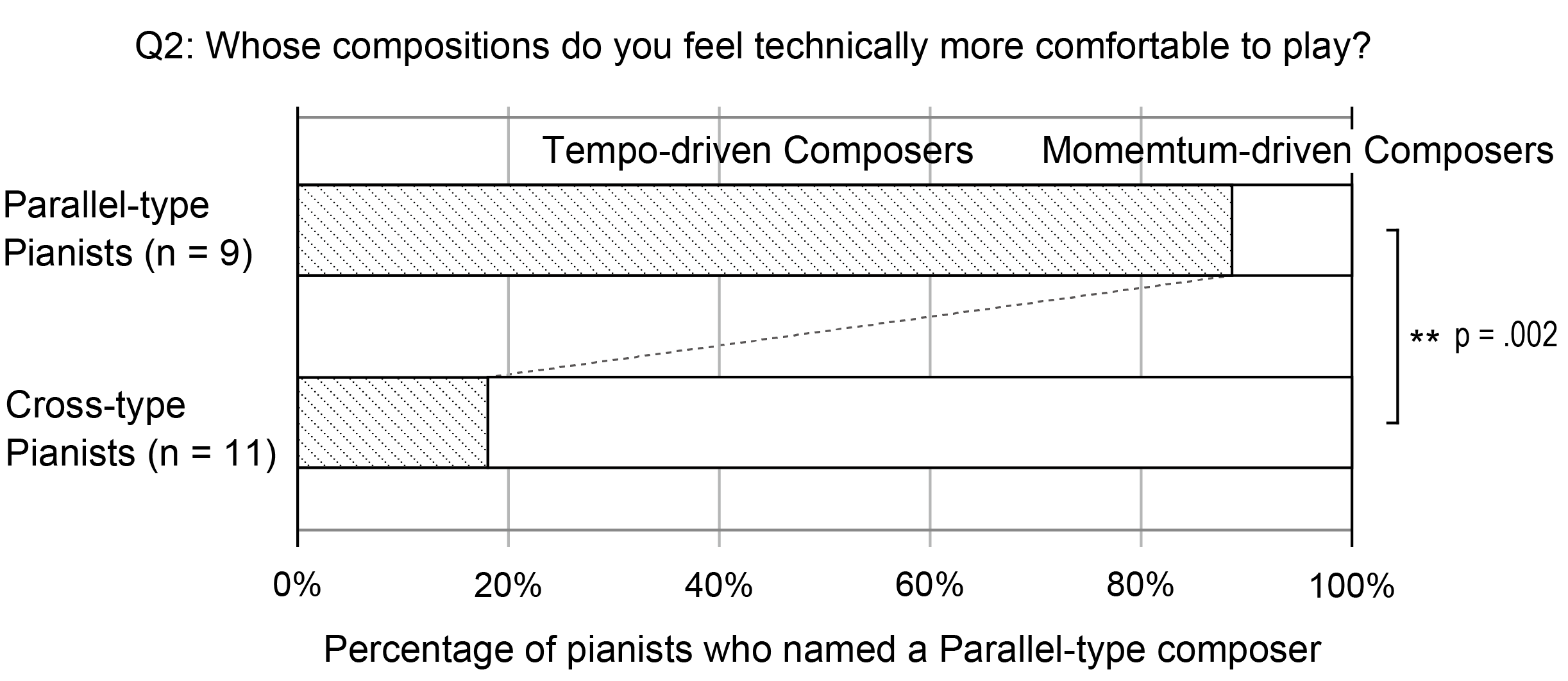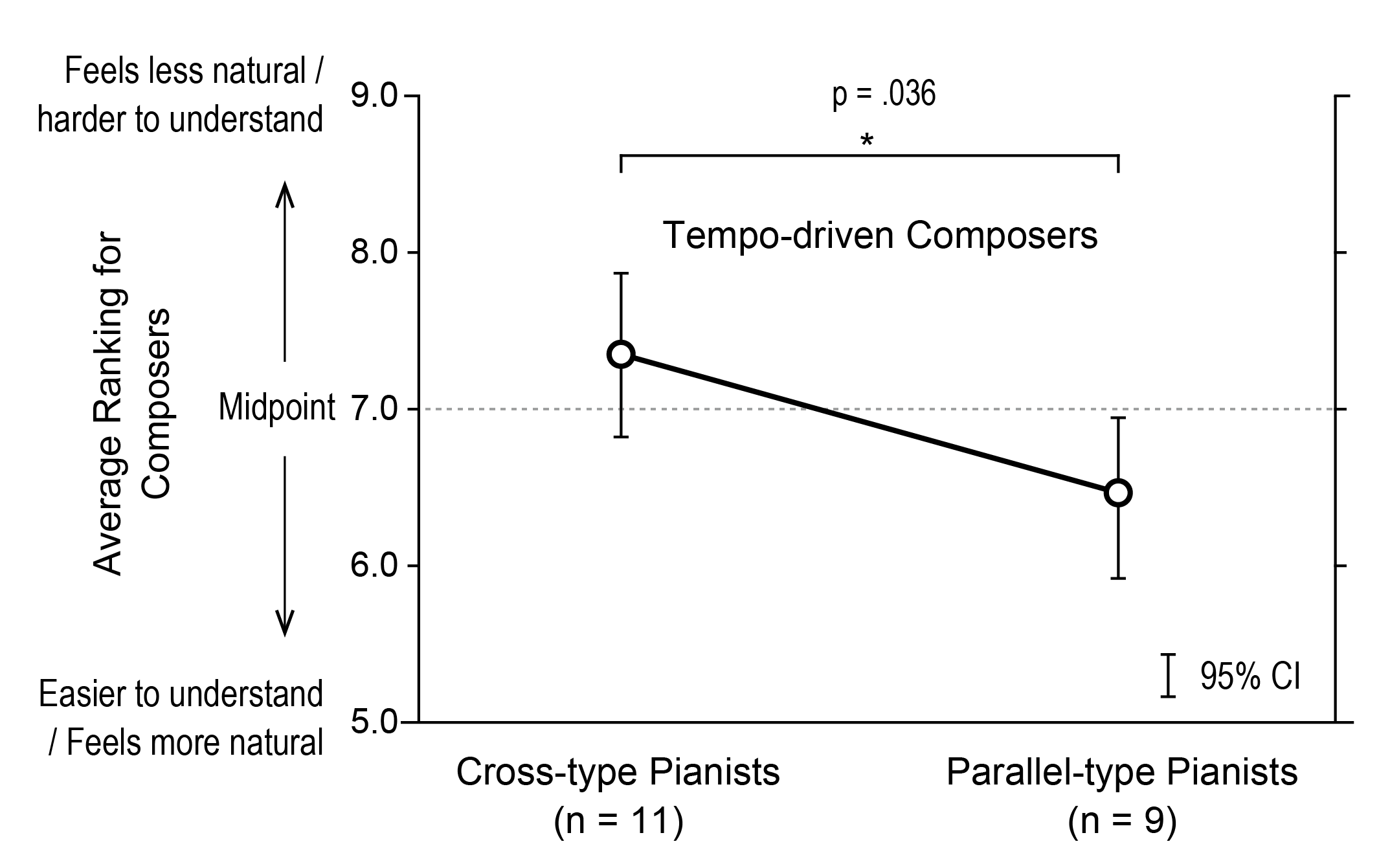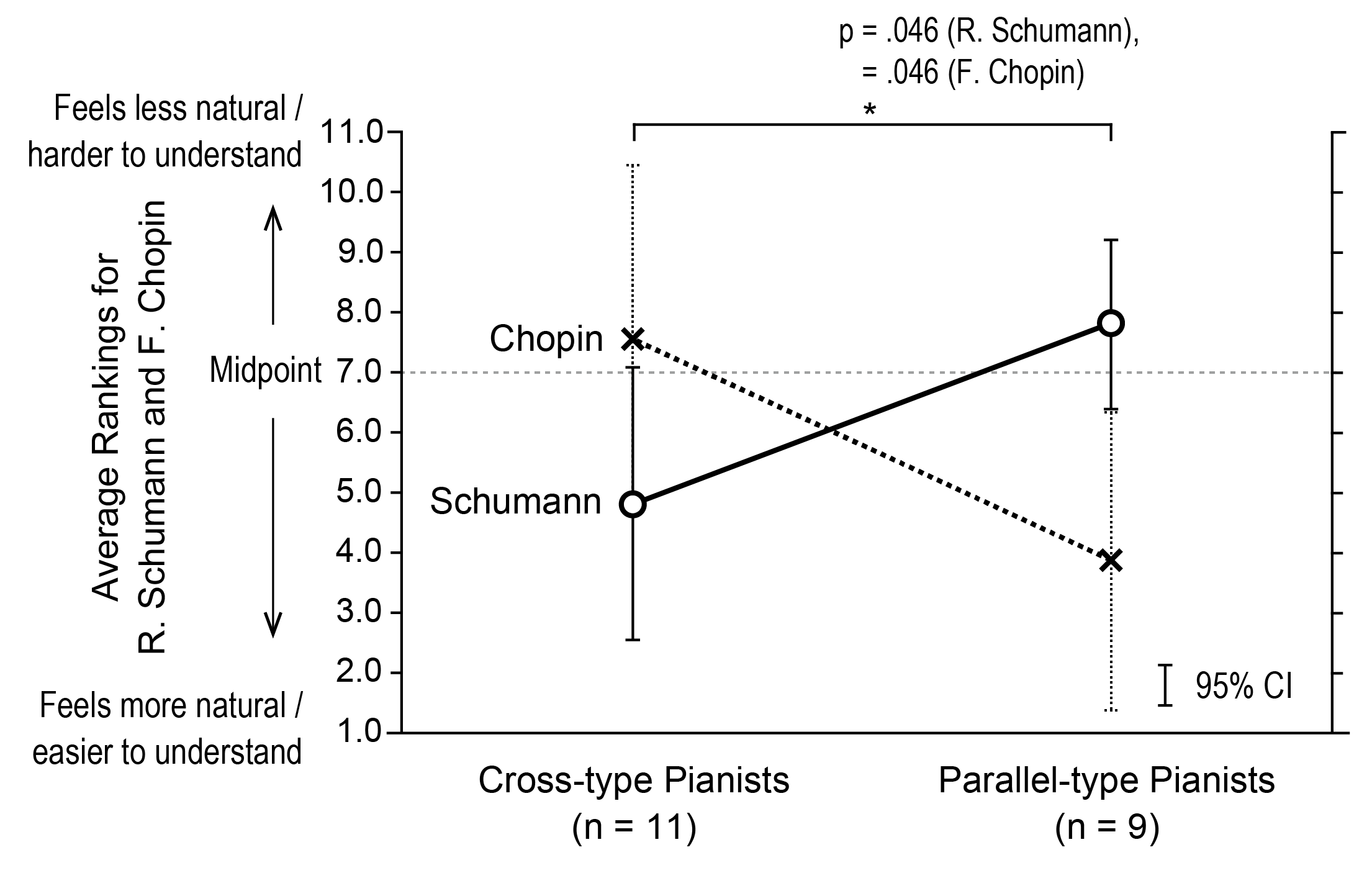INTRODUCTION
OVER the years, the piano has allured many to play it and love it. The instrument has developed significantly since the 18th century, as has the pedagogy of the instrument, often with widely differing approaches. Whereas Fryderyk Chopin studied the relationship between the keys of the instrument and the hands of the performers, teaching with a delicate touch (Eigeldinger & Shohet, 1986), Robert Schumann's teaching style emphasized the importance of performing with liveliness and passion, while keeping a very precise tempo (Schumann, 1854). In the late 19th Century and the early 20th Century, a new school of piano pedagogy that focuses on the physiology of human bodies was developed by pioneering educators like Marie Jaëll and Otto Ortmann. Based on experimental science, composer and pianist Marie Jaëll presented a new pedagogy that focused on the relationship between mind and body in her pedagogy manual, Touch: Piano Instruction on the Basis of Physiology, in 1899 (Weinstein-Reiman, 2020). Subsequently, music educator and scientist Ortmann concluded in his book that "the acquisition of pianistic movements is primarily a psychological process" and that muscular coordination changes with the tempo, intensity, and pitch of the music (Ortmann, 1929). Ortmann influenced later educators, including Arnold Schultz, who expanded Ortmann's work by further investigating muscular coordination (Schultz, 1949). This relatively new school considers it vital to understand how the fingers, arms, joints, and spine move during performance (Mark, Gary, & Miles, 2004). Table 1 shows an example of such a teaching school, where the educator recommends different postures based on the types of composers (Kobayashi, 2019).
| Momentum-driven Composers | Tempo-driven Composers |
|---|---|
|
|
| Examples: | Examples: |
| L.v. Beethoven R. Schumann C. Debussy S. Rachmaninov A. Scriabin | J.S. Bach J. Haydn W.A. Mozart F. Schubert J. Brahms M. Ravel F. Chopin B. Bartok F. Liszt |
Over the years, many educators have advocated for the efficacy of the physiological piano teaching methods (Kochevitsky, 1995; Sándor, 1981). However, human bodies are all different, and it has been very challenging for educators in the field to understand their students' physiological characteristics for an effective teaching style. Is there a way to achieve it? Can teachers predict what types of music suit their students physiologically? This paper explores a relatively new theory in sport science, called "the Four-Stance Theory". For the first time in piano pedagogy, it seeks to offer teachers a simple yet practical solution to discern the physiological nature of their students with this theory.
The Four-Stance Theory
The Four-Stance Theory was originally conceived by Souichi Hiroto as a coaching method for athletes. He empirically systemized how athletes move and use their muscles anatomically, and constructed a theory on how to coach them most effectively based on their anatomical characteristics.
Hiroto (2014) observes that "the way a human being uses one's body is different for all. The most natural way to move without stress and difficulties depends on each person, and there are four types of people out there." Hiroto continues that these four types can be classified based on the position of one's body's center of gravity, or "the point where one's body is stable without wavering around during a movement": the position of one's center of gravity is either located in the front [Stance A] or in the rear [Stance B]. Similarly, Hiroto (2016) theorizes that the position of one's center of gravity can be categorized into either the inner [Stance 1] or the outer [Stance 2]. These classifications are summarized in Table 2.
| Stance A | The center of gravity is located on an area towards one's toe when standing. |
|---|---|
| Stance B | The center of gravity is located on the heel area of the foot when standing. |
| Stance 1 | One's center of gravity is located towards the inner side of the feet. |
|---|---|
| Stance 2 | One's center of gravity is located towards the outer side of the feet. |
When put together, one can be classified into one of the following four stances: "Stance A1," with the front and the inner center of gravity; "Stance A2," with the front and the outer; "Stance B1," with the rear and the inner; and "Stance B2," with the rear and the outer. Finally, Hiroto (2016) groups these four stances into two types: people of Stance A1 and B2 as "Cross-type," and people of Stance A2 and B1 as "Parallel type." Figure 1 summarizes all four stances and two types.
According to Hiroto, each stance and type has different characteristics of how they use their muscles most naturally, and the Four-Stance Theory applies these observations to athletic coaching. For instance, when coaching runners, Hiroto proposes that trainers should instruct A1 and A2 athletes to concentrate on putting the weight on the leg that comes forward, whereas B1 and B2 athletes should focus on pushing the body from the leg that is behind the body.
Previous Studies on the Four-Stance Theory
Hiroto published a series of empirical studies on the theory's efficacy in athletic coaching for several sports, including golf (2007a), baseball (2007b), and soccer (2009). Empirical research followed: Suwa and Nishiyama (2009) presented a theory on the importance of the meta-cognitive recognition of one's body for athletes, based on the Four-Stance Theory. Tanaka, Ishimoto, Hashimoto, Sano, and Hiroto (2010) tested the efficacy of a Four-Stance Theory-based coaching system with magnetic sensing feedback. Koikawa (2011) discussed the usefulness of the Four-Stance Theory in delivering more personalized coaching to female track runners. Otake, Ogihara, Toyoda, Abe, and Ota (2011) referred to the Four-Stance Theory during their discussion about their experimental results on the efficacy of baseball pitching coaching. Mitsui, Tang, and Obana (2015) proposed a wearable support system for improving golf swing and interpreted the experimental results with the characteristic motions of body regions presented in the Four-Stance Theory. Tateno and Honda (2016) tested the efficacy of the Four-Stance Theory in Kendo training through an experiment focusing on the striking time.
Over the past several years, numerous educators started to apply the Four-Stance Theory to music pedagogy. There are only a few empirical studies published on this subject to date: Furukawa, Masuda, and Nishiyama (2016) collected data from the observation of 46 cellists, to conduct clustering of cello playing style inspired by the Four-Stance Theory. Fujinami and Furukawa (2017) discussed the applicability of the Four-Stance Theory to the cello pedagogy further, while Hara (2019) tested the efficacy of the Four-Stance Theory on vocal training through experiment. However, there are currently no scientific publications on the Four-Stance Theory in piano pedagogy to our knowledge.
METHODOLOGY
The piano is an instrument that requires the coordination of one's entire body to perform. As such, the Four-Stance Theory might prove useful in piano teaching as well. We theorize that pianists' natural fit to certain music pieces may have a relation to their physiology.
Hypothesis
To test this theory, we tested the following hypotheses: 2
Hypothesis 1. Parallel-type pianists favor tempo-driven composers over momentum-driven composers; the opposite applies to cross-type pianists.
Hypothesis 2. Parallel-type pianists feel more comfortable with playing the music of tempo-driven composers than that of momentum-driven composers; the opposite applies to cross-type pianists.
Hypothesis 3. Parallel-type pianists find it easier to understand tempo-driven composers' works than momentum-driven composers' works; the opposite applies to cross-type pianists.
If the evidence supports these hypotheses, piano teachers could be able to predict students' physiological fitness to perform certain composers' music based on their Stance Type. We hope that this will provide educators in the field with a simple yet practical method to understand students' physiological nature.
Experimental Design
To test the hypotheses, we conducted a paper-based survey that consisted of (a) physical tests to determine one's Stance Type and (b) a questionnaire on their opinions on composers (Appendix A). 3 Twenty volunteers (10 male and 10 female professional and university student pianists) aged between 20 and 30 agreed to participate in this experiment. We transmitted the survey sheet to individual research participants and collected the results electronically. The survey sheet used for this experiment is attached as Appendix A.
First, each research participant was asked to follow a series of physical test procedures established by Hiroto (2014). Tests I to III are used to determine their Front/Rear stance; tests IV to VI are used to determine their Inner/Outer stance. The decision table is attached as Appendix B.
Following the physical tests, each research participant was asked which composer they personally favor (Question 1) and feel most comfortable playing (Question 2). They were then asked to rank 13 composers from 1 to 13, with 1 being the composer whom they find easiest to understand (Question 3). In case a research participant named multiple composers for Question 1 or 2, only their first pick was recorded.
To avoid bias, research participants were not informed of what they were being tested for. They were also not informed of their Stance Types nor the classifications of any composers. None of the participants reported any prior knowledge of the Four-Stance Theory.
Testing
Chi-square tests of independence were performed to examine the relationship between the pianists' Stance Types and their preferred composers (Questions 1 and 2). Subsequently, the Mann-Whitney U-tests were conducted to compare the average rankings of composers (Question 3).
RESULTS
Stance Type
Out of the 20 research participants, four were identified as Stance A1, six as Stance A2, three as Stance B1, and seven as Stance B2. In terms of Cross/Parallel types, nine were Parallel-type and 11 were Cross-type. The raw survey results are attached as Appendix C.
Favorite Composers
For Question 1, a chi-square test of independence was performed to examine the relationship between pianists' Stance Type (Cross- or Parallel-type) and their favorite composer (momentum- or tempo-driven).
The relation between these two variables was significant (𝒳2= 5.69, df=1, N=20, p=.017). As shown in Figure 2, Parallel-type pianists were more likely to name a tempo-driven composer as their favorite (88.9% named a tempo-driven composer); Cross-type pianists were more likely to name a momentum-driven composer as their favorite (63.6% named a momentum-driven composer).
Comfortable Composers to Perform
For Question 2, a chi-square test of independence was performed to examine the relationship between pianists' Stance Type (Cross- or Parallel-type) and the type of composer they feel is most technically comfortable to perform (momentum or tempo-driven).
The relation between these two variables was significant (𝒳2 = 9.90, df=1, N = 20, p =.002). As shown in Figure 3, Parallel-type pianists were more likely to name a tempo-driven composer (88.9% named a tempo-driven composer); Cross-type pianists were more likely to name a momentum-driven composer as a composer whose works they feel most technically comfortable playing (81.8% named a momentum-driven composer).
Stance Type and Ease of Understanding
For Question 3, we conducted independent 2-group Mann-Whitney U tests to compare the average rankings of composers in Parallel-type pianists and Cross-type pianists.
Cross-type pianists ranked momentum-driven composers lower (average ranking = 6.36) than Parallel-type pianists (average ranking = 7.76). A Mann-Whitney test indicated that this difference was statistically significant, U(NCross-type = 11, NParallel-type = 9) = 20.5, p = .03 (see Figure 4 (a)). Similarly, Parallel-type pianists ranked tempo-driven composers lower (average ranking = 6.46) than Cross-type pianists (average ranking = 7.34). A Mann-Whitney test indicated that this difference was statistically significant, U(NCross-type = 11, NParallel-type = 9) = 77.5, p = .036 (see Figure 4 (b)).
DISCUSSION
This study explored the applicability of a relatively new physiological theory in sport science called "The Four-Stance Theory" to piano pedagogy. The authors hypothesized that the pianists' Stance Type, a physiological characteristic defined in the Four-Stance Theory, can predict pianists' preferences for certain composers' music. To examine this theory, the authors carried out an experiment with 20 research participants (professional and university student pianists; 10 male and 10 female) and tested the following three hypotheses.
Hypothesis 1. Parallel-type pianists favor tempo-driven composers over momentum-driven composers; the opposite applies to Cross-type pianists.
Experimental results in Section 3.2 support Hypothesis 1 with statistical significance (p < .05). As much as 88.9% of Parallel-type pianists named a tempo-driven composer as his/her favorite; likewise, 63.6% of Cross-type pianists named a momentum-driven composer.
Hypothesis 2. Parallel-type pianists feel technically more comfortable playing the works of tempo-driven composers over those of momentum-driven composers; the opposite applies to Cross-type pianists.
Hypothesis 2 is supported by experimental results in Section 3.3 with statistical significance (p < .01), with 88.9% of Parallel-type pianists naming a tempo-driven composer and 81.8% of Cross-type pianists naming a momentum-driven composer as the composer whose music they feel most comfortable to perform.
Hypothesis 3. Parallel-type pianists find it easier to understand tempo-driven composers' works than momentum-driven composers' works; the opposite applies to Cross-type pianists.
The third and last hypothesis is supported by the results in Section 3.4 with statistical significances (p < .05). On average, momentum-driven composers were ranked lower by Cross-type pianists than by Parallel-type pianists (average rank of 6.36 vs. 7.76). Likewise, tempo-driven composers were ranked lower by Parallel-type pianists (average rank of 6.46 vs. 7.34).
To summarize, the results of this experiment quantitatively indicate that pianists may have natural affinities to certain composers' music based on their physiological characteristics. As illustrated in Figure 5, there were significant correlations between pianists' Stance Types and their preferences for certain composers. Cross-type pianists showed higher affinities (more comfortable to perform and easier to understand) towards momentum-driven composers, whereas Parallel-type pianists showed higher affinities towards tempo-driven composers.
Pianists who favor 'high-affinity' composers (p < .05), feel technically more comfortable playing the works of a 'high-affinity' composer (p < .001), and feel it to be easier to understand the music of 'high-affinity' composers (p < .05). Considering that research participants were not informed of what they were being tested for, nor were they given any knowledge on the Four-Stance Theory prior to the survey, it is surprising that a binary metric as simple as Parallel or Cross-type predicted their preferences for certain composers this clearly.
Based on the findings, the authors conclude that the Cross/Parallel test could be effective in understanding pianists' physiological nature and predicting what composers' music suits them physiologically.
Potential Value of the Four-Stance Theory in Piano Teaching
This study aimed to explore ways to provide teachers in the field with a simple yet practical solution to understand the physiological natures of their students. Judging by the results, this simple 10-minute physical test may have achieved this goal effectively.
The Cross/Parallel test (Appendix A: Tests I - VI) can easily be carried out in the field. This may open up a new pathway towards connecting traditional and physiological piano teaching methods. Recognizing a correlation between pianists' physiology and their affinities to certain composers would enable both teachers and students to plan better on how to approach pieces for which they are not a good fit. In other terms, the authors envision that this simple test could be useful for bringing physiological preparedness to both teachers and students.
Limitations
Due to the COVID-19 situation, the experiment was conducted remotely and the number of research participants was fairly limited due to budget constraints (n = 20). While every effort was made to improve the reliability of the experiment by avoiding bias, we welcome replication studies to ensure the replicability of the findings.
Another limitation may come from the subjectiveness of the classifications of composers (Table 1). While it is certainly subjective to a degree, the classification was carried out prior to this study and the authors were not involved in the classification process. Furthermore, research participants were not informed of the classification during the experiment. Therefore, the potential subjectiveness of the list does not create a bias, and, therefore, does not diminish the value of the findings.
One factor the authors did not consider in the statistical analysis is the effect of the number of composers on the probability of getting listed as the participant's favorite. It could be argued that there's a greater likelihood of listing a tempo-driven composer instead of a momentum-driven composer because there are nine of the former and only five of the latter (Table 1). However, we maintain that it is not a valid argument to presume the number of composers would dictate the frequency of getting picked. The list of momentum-driven composers includes popular composers like Beethoven and Schumann, and it is not reasonable to quantify the general probability of getting picked purely based on the number of composers. For this reason, what matters is whether there is a statistically significant difference between the frequencies between the Parallel-type and Cross-type pianists. Therefore, this is why the effect of the number of composers is neglected in the statistical analyses.
Finally, while this study showed correlations between pianists' Stance Types and their preferences for certain composers, the causalities between the two are still unexplored. This study did not investigate any mediator variables; therefore, it might also be possible that the Stance Type correlates with other physical features that are the actual predictors for their preferred composers. These points should be further investigated in future studies.
Concluding Question: Why do I like Schumann more than Chopin?
Over the years, we were told, "to love Schumann, you need to be crazy" – crazy for love, for music, for literature. People say you need to be temperamental because his pieces are happy in one moment and sad in another. So, authors have always questioned themselves; do I feel a special bond to Schumann because he is eccentric and so am I? Why is it difficult for me to play or to understand other composers like Chopin?
The result of this study sheds light on this lifelong question. In our experiment, Schumann's popularity was polarized between Cross-type and Parallel-type pianists (average ranking being 4.82 vs. 7.78, p < 0.05). This makes a stark contrast to Chopin, who was another polarized composer but in the opposite direction (7.55 vs. 3.89, p < 0.05). This contrast is illustrated in Figure 6.
Figure 6 suggests that taste for music may be different physiologically for Cross-type and Parallel-type pianists, and Schumann might just happen to be a typical example of it. The R2 value of a simple regression predicting Schumann's ranking (dependent variable) based on pianists' Cross/Parallel Type (predictor), is .235 (p < .05).
ACKNOWLEDGEMENTS
The authors sincerely thank all research participants who kindly volunteered for the experiment. This article was copyedited by Eve Merlini and layout edited by Jonathan Tang.
NOTES
-
Correspondence can be addressed to: Associate Professor, Shutaro Takeda, Graduate School of Advanced Integrated Studies in Human Survivability, Kyoto University: Nakaadachi, 606-8306 Kyoto, Japan, takeda.shutarou.55r@kyoto-u.jp
Return to Text -
The classification of the composers was directly taken from Kobayashi (2019) in Table 1.
Return to Text -
Due to the COVID-19 situation, it was not possible to carry out the survey in person.
Return to Text
REFERENCES
- Eigeldinger, J.-J., & Shohet, N. (1986). Chopin: pianist and teacher: as seen by his pupils: Cambridge University Press. https://doi.org/10.1017/CBO9781107049901
- Fujinami, T., & Furukawa, K. (2017). Embodied knowledge for musical performance. Journal of Japanese Society for Artificial Intelligence, 32(2), 242-246.
- Furukawa, K., Masuda, T., & Nishiyama, T. (2016). On clustering cellists using acquired data through performance movies observation. Paper presented at the The 30th annual conference of the Japanese Society for Artificial Intelligence, Kitakyushu.
- Hara, N. (2019). A study on effectiveness in singing and teaching using "Four-Stance Theory" [in Japanese]. (Masters Degree). Tokyo Gakugei University, Tokyo.
- Hiroto, S. (2007a). Golf Four-Stance Theory - There are 4 types of correct forms. So different depending on the types! [in Japanese]. Tokyo: Ikeda Shoten.
- Hiroto, S. (2007b). Improving baseball with "Four-Stance Theory"! [in Japanese]. Tokyo: MC Press.
- Hiroto, S. (2009). Soccer Four-Stance Theory [in Japanese]. Tokyo: Ikeda Shoten.
- Hiroto, S. (2014). Four-Stance Theory Bible [in Japanese]. Kishiwada: Jitsugyo no Nihon Sha.
- Hiroto, S. (2016). The amazing way to use the body by bringing out its full potential [in Japanese]. Tokyo: Nihon Bungeisha.
- Kobayashi, D. (2019). Categorizing composers based on Four-Stance Theory (presented during a lecture, personal communication). Tokyo Gakugei University. Tokyo.
- Kochevitsky, G. (1995). The art of piano playing: a scientific approach. Los Angeles: Alfred Music.
- Koikawa, N. (2011). My coaching theory: coaching for women's long distance runners [in Japanese]. The Japan Journal of Coaching Studies, 24(2), 95-97.
- Mark, T., Gary, R., & Miles, T. (2004). What every pianist needs to know about the body. Chicago: GIA Publications.
- Mitsui, T., Tang, S., & Obana, S. (2015). Support system for improving golf swing by using wearable sensors. Paper presented at the 2015 eighth international conference on Mobile Computing and Ubiquitous Networking (ICMU). https://doi.org/10.1109/ICMU.2015.7061049
- Ortmann, O. (1929). The physiological mechanics of piano technique. New York: The International Library of Music.
- Otake, M., Ogihara, Y., Toyoda, R., Abe, K., & Ota, J. (2011). Transfer of verbalized physical skill: analysis of ball speed change by acquisition of pitching movement skill. Paper presented at the the 11th SIG-SKL conference, Tokyo.
- Sándor, G. (1981). On piano playing: motion, sound and expression. Stanford: Cengage Learning.
- Schultz, A. (1949). The riddle of the pianist's finger. New York: Carl Fischer.
- Schumann, R. (1854). Gesammelte schriften über musik und musiker. Leipzig: Georg Wigand's Verlag.
- Suwa, M., & Nishiyama, T. (2009). What does "athletes' thinking own body" mean? Paper presented at the the 9th SIG-SKL conference, Tokyo.
- Tanaka, M., ishimoto, Y., Hashimoto, W., Sano, M., & Hiroto, S. (2010). PD-10 A coaching system with a position of the center of gravity in daily lives - A sencing feedback teaching [in Japanese]. Paper presented at the the 37nd general conference of Japanese Society of Biofeedback Research, Osaka.
- Tateno, R., & Honda, S. (2016). A study on the effectiveness of Kendo teaching that applies 4 Stance Theory - with focus on the striking time -. Bulletin of Fukuoka University of Education, 65(5), 115-121.
- Weinstein-Reiman, M. (2020). Printing piano pedagogy: experimental psychology and Marie Jaëll's Theory of Touch. Nineteenth-Century Music Review, 1-27. https://doi.org/10.1017/S1479409819000715
APPENDIX
Appendix A. Survey Sheet
In each test you will try two ways and will check which is easier for you to move more smoothly and which allows you to feel stable and well-coordinated.
In order to take an accurate result, keep in mind the following;
- There is no better or worse. Being able to do both equally well is not the point of the test;
- Feel your bone and the muscles;
- Forget what you may have learnt in the process of growing up, just concentrate on your own body; Relax after each movement.
I. Take a chair, put one leg in the following 2 ways and bend your leg several times. Which is more stable?
1. When you put the leg on the chair behind you and bend the knee
2. When you put the leg on the chair in front of you and bend the knee
If it is difficult to tell, try bending further down or do it faster.
II. Stand up straight, bend down to touch the floor in 2 different ways. Which allows you to bend further and more stable?
1. Bend down to touch the floor by sliding your hands on the front side of your body (thighs -> front of knee -> shin)
2. Bend down to touch the floor by sliding your hands on the back side of your body (Back of thigh -> back of knee -> calves)
III. Stand with your legs in the width of your hips, raise your arms in 2 ways and slowly twist from right to left. Keep your face up, don't move your hips and twist slowly.
1. Raise your arms to the side, in one line
2. raise your arms around 45 degrees downwards
IV. Make an OK sign with your fingers, raise your arm horizontally and open it towards the side.
1. Make an OK sign with your thumb, point finger, middle finger
2. Make an OK sign with thumb, ring finger and index finger
Don't move your upper body, just slowly open your arm. Which allows you to open smoothly and further?
V. Stand in the width of your hips. Put your palms together in front of your chest and slowly twist your upper body.
1. Raise the outer side of your feet, placing your inner gravity towards the inside
2. Raise the inner side of your feet, placing your inner gravity towards the outside
Which allows you to twist more stably and further?
VI. Sit down on a chair. Have your thighs twisted in 2 different directions and see which one is easier to sit down and stand up. Don't use energy from swing. Stand up and sit down with your own power
1. When having your thighs twisted inside
2. When having your thighs twisted outside
Questionnaire
- Who is your favorite composer? If there are multiple favorite composers, who do you feel the personal bond to?
- Whose compositions do you feel technically more comfortable playing?
- Rank in 1-13, 1 being the highest, 13 being the lowest.
Rank based on how easy it is for you to understand their music and how natural it feels for you to play and feel that composer's music.
| Composers | Rank [1 - 13] |
|---|---|
| J.S. Bach | |
| J. Haydn | |
| L. v. Beethoven | |
| W. A. Mozart | |
| F. Schubert | |
| J. Brahms | |
| R. Schumann | |
| C. Debussy | |
| M. Ravel | |
| F. Chopin | |
| S. Rachmaninov | |
| B. Bartok | |
| A. Scriabin |
Appendix B. Decision Table
| Test I | Test II | Test III | Criteria | ||||
|---|---|---|---|---|---|---|---|
| Answer | 1 | 2 | 1 | 2 | 1 | 2 | If indicated A ≥ 2 times, Stance A; if indicated B ≥ 2 times, Stance B. |
| Indication | Stance A | Stance B | A | B | A | B | |
| Test IV | Test V | Test VI | Criteria | ||||
|---|---|---|---|---|---|---|---|
| Answer | 1 | 2 | 1 | 2 | 1 | 2 | If indicated Stance 1 ≥ 2 times, Stance 1; if indicated Stance 2 ≥ 2 times, Stance 2. |
| Indication | Stance 1 | Stance 2 | 1 | 2 | 1 | 2 | |
Appendix C. Survey Results
Table A3. Survey Results from 20 Research Participants.

